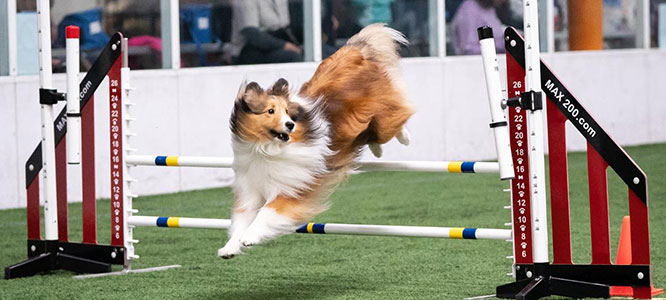Belroi Agility Club of Virginia FAQs
Although you do not need to have attended a formal obedience class, you need some basic skills. Your dog should understand commands for sit, stay, and come. He need not be 100% reliable, but this is a good place to begin.
In the Beginner Class, you will introduce your dog to the obstacles on leash. In the more advanced classes, all work is done off leash. Only one dog is off leash in class at a time. It is important that your dog has a good “come” command as he may be distracted and want to run over to other dogs.
Your dog needs to be physically developed to jump and weave and mentally developed to understand the obedience skills already discussed – this age will be different for every dog. Your dog should be at least 12 months old before taking our agility classes. Large breed dogs mature more slowly. If you have a large breed dog, please consult your veterinarian about whether she is physically mature enough to do agility. Older dogs need to be physically healthy. Yes, old dogs can learn new tricks.
Junior handlers are always welcome at Belroi. Kids are often very good students and can have a lot of fun running with their dogs. They need to be old enough to stay focused for an hour during class. We recommend that a parent, or other responsible adult, be present while young children are in class. We have had handlers of all ages, from 9 to 83 years old.
No. Most students begin taking agility classes just to have fun with their dogs. Some get bitten by the bug and go on to compete at agility trials.
Your dog needs to have had her rabies, Bordetella and distemper/Parvo vaccinations to take our agility classes. Please bring proof of these vaccinations when registering your dog for class.
You will need LOTS of yummy treats for your dog! Treats should be soft and small (your dog will get a lot of them). You can cut up hotdogs, string cheese, or you can get treats from a pet supply store. Pick treats that you don’t give to your dog every day. This will help your dog value the treat more and help keep him motivated during your training classes.
Your dog should come to class wearing a flat buckle or clip style collar, and a 4–6-foot leash. She should not wear a body harness, or head halter – they can interfere with your dog’s ability to perform some of the agility obstacles.
Bring water for your dog, and a water bowl.
That depends on many things and will vary from team to team. The speed of your progress does not matter. What is important is learning the fundamental skills at the beginning properly. Once you have trained your dog to make “mistakes”, it is difficult to go back and “fix” them. Please remember that your instructor probably made those same “mistakes” with the first dog they trained, and they learned from their mistakes! Do not compare the speed of your progress to other teams in your class.
If your dog lunges at other dogs or attacks them, he cannot take agility classes. You may wish to consult a dog behavior specialist to help you control these problems.
Yes! AKC considers mixed breed dogs as “All American” dogs and they are welcome to compete. Any dog can be registered with AKC as a PAL or All-American.
Some suggested sites:
For instructions on how to make your own agility equipment enter “TheDogBlog agility equipment” on YouTube



